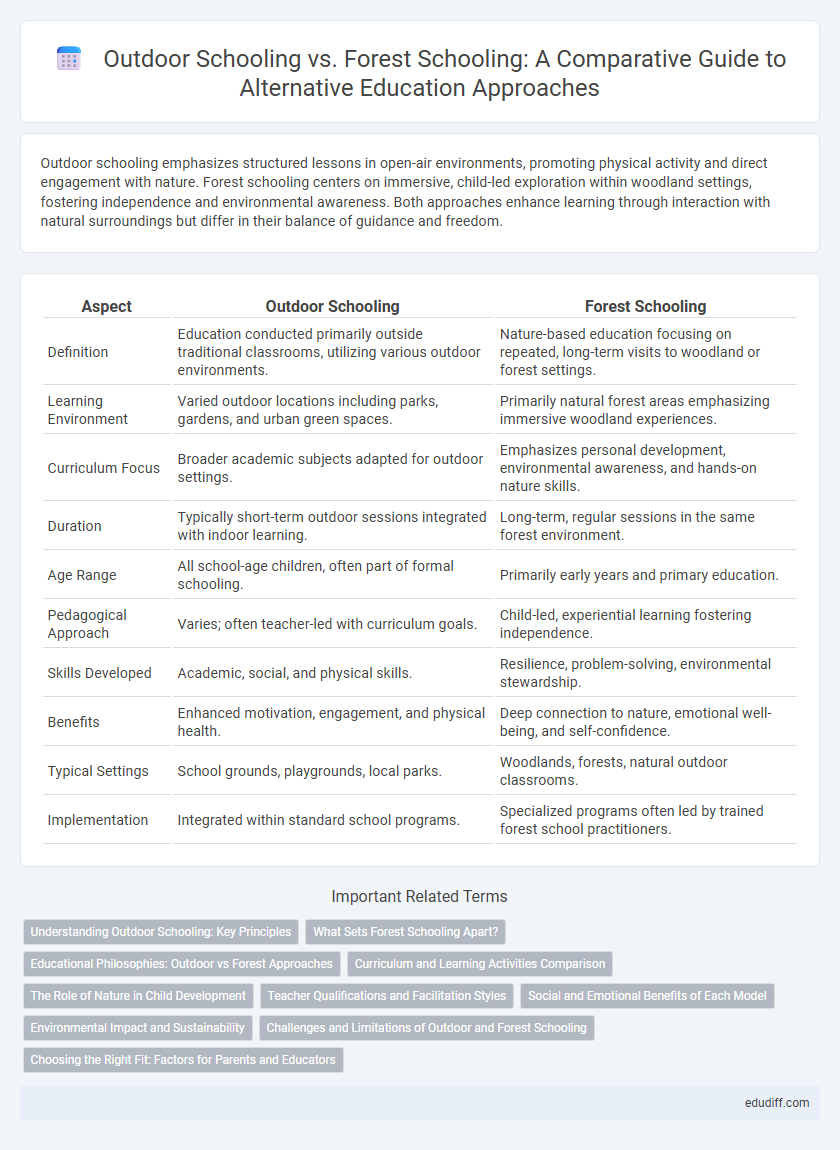Outdoor schooling emphasizes structured lessons in open-air environments, promoting physical activity and direct engagement with nature. Forest schooling centers on immersive, child-led exploration within woodland settings, fostering independence and environmental awareness. Both approaches enhance learning through interaction with natural surroundings but differ in their balance of guidance and freedom.
Table of Comparison
| Aspect | Outdoor Schooling | Forest Schooling |
|---|---|---|
| Definition | Education conducted primarily outside traditional classrooms, utilizing various outdoor environments. | Nature-based education focusing on repeated, long-term visits to woodland or forest settings. |
| Learning Environment | Varied outdoor locations including parks, gardens, and urban green spaces. | Primarily natural forest areas emphasizing immersive woodland experiences. |
| Curriculum Focus | Broader academic subjects adapted for outdoor settings. | Emphasizes personal development, environmental awareness, and hands-on nature skills. |
| Duration | Typically short-term outdoor sessions integrated with indoor learning. | Long-term, regular sessions in the same forest environment. |
| Age Range | All school-age children, often part of formal schooling. | Primarily early years and primary education. |
| Pedagogical Approach | Varies; often teacher-led with curriculum goals. | Child-led, experiential learning fostering independence. |
| Skills Developed | Academic, social, and physical skills. | Resilience, problem-solving, environmental stewardship. |
| Benefits | Enhanced motivation, engagement, and physical health. | Deep connection to nature, emotional well-being, and self-confidence. |
| Typical Settings | School grounds, playgrounds, local parks. | Woodlands, forests, natural outdoor classrooms. |
| Implementation | Integrated within standard school programs. | Specialized programs often led by trained forest school practitioners. |
Understanding Outdoor Schooling: Key Principles
Outdoor schooling emphasizes experiential learning by immersing students in natural environments to enhance sensory engagement and foster environmental stewardship. Core principles include child-led exploration, hands-on activities, and integrating curriculum objectives with real-world contexts. This approach supports cognitive development, social skills, and physical health through direct interaction with nature.
What Sets Forest Schooling Apart?
Forest schooling sets itself apart through immersive, nature-based learning that emphasizes child-led exploration within natural woodland environments. Unlike traditional outdoor schooling, forest schools prioritize emotional development, resilience, and risk-taking by engaging children in unstructured play and real-world problem-solving in forests. This approach fosters deep environmental stewardship and holistic growth by connecting learners directly with diverse ecosystems over extended periods.
Educational Philosophies: Outdoor vs Forest Approaches
Outdoor schooling emphasizes experiential learning in diverse natural environments, integrating curriculum goals with outdoor activities to enhance student engagement and practical skills. Forest schooling centers on child-led exploration within forest settings, prioritizing emotional resilience, social development, and connection to nature through unstructured play and observation. Both philosophies promote environmental stewardship but differ in structure, with outdoor schooling often more curriculum-driven and forest schooling rooted in holistic, nature-immersive pedagogy.
Curriculum and Learning Activities Comparison
Outdoor schooling emphasizes structured curriculum aligned with national education standards, incorporating traditional subjects taught in open-air environments to enhance engagement and retention. Forest schooling adopts a learner-centered approach focused on experiential learning through nature-based activities such as shelter building, foraging, and ecological observation, fostering emotional resilience and environmental stewardship. Both models promote physical activity and social skills development but differ in curricular flexibility and pedagogical priorities.
The Role of Nature in Child Development
Outdoor schooling harnesses natural environments to enhance cognitive and emotional growth, emphasizing direct interaction with diverse ecosystems that stimulate curiosity and resilience. Forest schooling, as a specialized form of outdoor education, immerses children in woodland settings where unstructured play and exploration foster problem-solving skills and social cooperation. Nature exposure in both methods strengthens sensory development, reduces stress, and supports holistic well-being, making it critical to child development theories in alternative education.
Teacher Qualifications and Facilitation Styles
Outdoor schooling often requires formal teaching credentials aligned with national education standards, emphasizing structured lesson plans and curriculum adherence. Forest schooling prioritizes facilitators trained in experiential learning and child-led discovery, valuing emotional development and nature connection over rigid academic benchmarks. Both approaches demand specialized skills, but forest school instructors typically employ a flexible, observational style fostering autonomy and environmental stewardship.
Social and Emotional Benefits of Each Model
Outdoor schooling promotes social skills through structured group activities and collaborative learning, enhancing peer interaction and communication. Forest schooling emphasizes emotional development by fostering resilience, self-confidence, and a deep connection to nature through unstructured, child-led exploration. Both models support improved emotional regulation and social competence, albeit through distinct experiential approaches tailored to children's needs.
Environmental Impact and Sustainability
Outdoor schooling promotes environmental stewardship by integrating diverse ecosystems into the curriculum, enhancing students' understanding of sustainability through direct interaction with natural landscapes. Forest schooling, as a specialized form of outdoor education, emphasizes long-term ecological responsibility by immersing learners in woodland habitats, fostering deep connections with flora and fauna, and encouraging conservation practices. Both approaches reduce carbon footprints compared to traditional indoor classrooms by minimizing reliance on artificial resources and promoting renewable, nature-based learning environments.
Challenges and Limitations of Outdoor and Forest Schooling
Outdoor and forest schooling face challenges including unpredictable weather conditions that limit consistent attendance and outdoor activities. Limited access to suitable natural environments in urban areas restricts program availability and diversity of learning experiences. Safety concerns and the need for trained educators competent in outdoor risk management further constrain the widespread implementation of these alternative education methods.
Choosing the Right Fit: Factors for Parents and Educators
Outdoor schooling emphasizes structured curriculum delivery in natural settings, while forest schooling prioritizes child-led exploration and connection with nature. Parents and educators should consider children's learning styles, developmental needs, and safety measures to determine the best fit. Accessibility, instructor qualifications, and program goals play critical roles in making an informed decision between these alternative educational approaches.
Outdoor Schooling vs Forest Schooling Infographic

 edudiff.com
edudiff.com